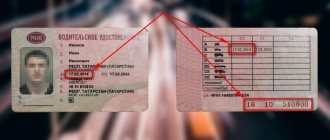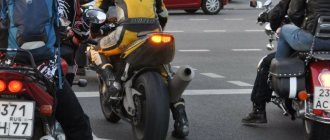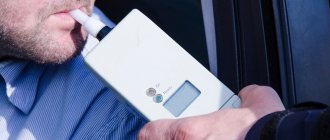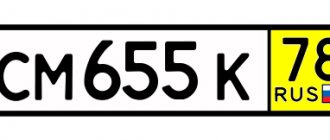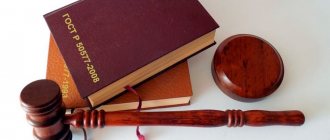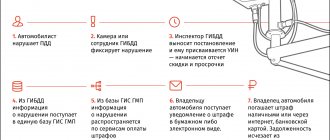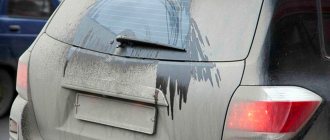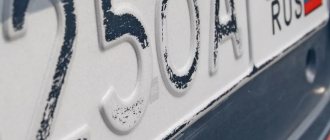What is the fine for unreadable numbers?
So, the very first part of Article 12.2 states that the driver is subject to a warning or a fine of 500 rubles for unreadable license plates. Please note that a fine is imposed only for driving a car with unreadable license plates or one license plate. If the car is stationary, there is no fine for this.
In what cases are numbers considered unreadable? The numbers will be recognized as such by the traffic police inspector if he fails to read at least one letter or number from a distance of 20 meters (note to Article 12.2). At the same time, the inscription “RUS” and the image of the flag may be unreadable, there is no fine for this. There is a difference in unreadability depending on the time of day. Since the front number plate is not illuminated in the dark, there is no requirement for its readability from 20 meters, but the rear number plate must be readable at any time. During daylight hours, both license plates should be readable - again, from a distance of 20 meters.
At the same time, the unreadability of numbers here does not include that due to their concealment and modification. The reasons for unreadability can be, for example, the following:
- the room is covered in dirt, snow, etc. (not on purpose, of course)
- the number has been erased (the black letters or numbers on the number have been erased),
- something accidentally stuck to the number (precisely by accident, but this may be a controversial point).
What is the fine for license plates installed in violation of GOST?
The same part of the article provides for a similar fine of 500 rubles for numbers that are installed in violation of the requirements of GOST R 50577-93. The list of such requirements is quite broad, but quite understandable and memorable.
Let's list how it is prohibited to install license plates in order to get fined for incorrectly installed license plates:
- the number must be installed perpendicular to the length of the car with a deviation of no more than 3o;
- the number must be installed perpendicular to the road surface with a deviation of no more than 5o;
- the distance from the road surface to the bottom edge of the sign must be at least 30 cm, and for two-wheelers and snowmobiles - 20 cm;
- Visibility should be ensured at the following angles in the diagram below:
- the number can only be attached to the holes on it with light-colored bolts or other light-colored elements;
- you can attach the number to the frame, but the frame should not cover the letters and numbers of the license plate (as well as the bolts in the holes);
- It is prohibited to drill additional holes into the license plate.
The fine here is also provided only for driving a car with such violations.
How legal are frame shifters?
Until November 2014, motorists could “cunning” and not catch the eye of representatives of the law. But a couple of years ago this omission in the law of the Russian Federation was corrected and today, before using shifters, you need to refer to Chapter 12, paragraph 12.2 of the Code of Administrative Offenses of the Russian Federation. This document deals with driving a car in violation of the rules for installing license plates on it. If we translate from the tricky legal phrases, it turns out that the law prohibits driving a vehicle without a license plate, as well as if the registration numbers are equipped or modified using special means or materials that prevent the identification of the car’s license plate. The same applies to attempts to hide numbers altogether.
If such a violation is recorded, the driver faces the following:
- administrative fine (5,000 rubles);
- deprivation of the right to drive a motor vehicle for a period of 1 to 3 months.
If the number turns out to be “false,” then the period of deprivation of rights can be increased to a year, and a fine will have to be paid in the amount of at least 25 minimum wages (by the way, this very minimum salary today is about 6,000 rubles). Therefore, it is better if the frame of the number plate is used for its intended purpose.
What is the penalty for hidden numbers?
Hiding numbers in 2021 is punishable by more severe penalties. And a fine is not the only punishment here. For a deliberately hidden license plate, a fine of 5,000 rubles or deprivation of rights for 1-3 months (by decision of the official or judge considering the case) is imposed under Part 2 of Article 12.2 of the Code of Administrative Offenses. Only driving a car with hidden license plates is punishable in the same way.
Meanwhile, the line between hiding the number from being readable and making the license plate unreadable is quite thin. And the main factor here is precisely the intentionality of the concealment. If the room was deliberately splashed with mud or snow, then this is a cover-up; if by chance, then an unreadable number.
A reasonable question is how will a traffic police inspector determine whether the number is hidden intentionally or unintentionally? Alas, but at your own discretion. According to the Code of Administrative Violations, the composition of many violations and the driver’s guilt in them are determined by the body considering the case based on personal conviction, but having comprehensively and most fully considered all the circumstances and evidence (26.11 of the Administrative Code). You, if a decision is made not in your favor, can appeal such decisions.
Concealing a number includes such actions and circumstances as:
- use of curtains on rooms;
- the use of reflective film (the above GOST generally prohibits applying any coating to the number);
- covering the numbers with any objects (paper, rag, etc.);
- deliberately staining the license plates with mud, snow, clay, etc.;
- and another case described below...
Fine or deprivation of rights for upside down numbers
The fact is that such a “life hack” as inverted numbers, which allows you to avoid punishment from auto-fixation cameras, is practically not described anywhere in legislative acts. GOST for license plates also does not prescribe that the numbers must be placed so that they are not read upside down or that the back and front parts of the license plate must not be swapped.
And here the issue is not so easily resolved, including in practice. If the number is turned upside down, then the punishment for this can be either under Part 1 or Part 2 of Article 12.2 of the Code of Administrative Offenses. At the same time, logic dictates that there may not be a violation at all in this case. The fact is that an upside down number is quite readable, and the inspector doesn’t even need to break his neck to do this - everyone can read the text upside down.
On the other hand, GOST stipulates that the white stripe of the Russian flag should be on top and the red stripe on the bottom:
The image of the State Flag of the Russian Federation should be a rectangle with equal horizontal stripes: the top stripe is white, the middle stripe is blue and the bottom stripe is red.
But here again, with the violation, not everything is so simple. This note in GOST refers to the installed types of license plates themselves and has nothing to do with the requirements for their installation on a car. That is, the flag still remains in the correct position relative to the top and bottom edges of the number itself - it’s just that the number is hung upside down on the car. Simply put, the white stripe of the flag is on top of the number (but from below towards the road), and this GOST clause refers specifically to the position relative to the number.
But having an upside-down license plate with the front side facing the car, when its back side is visible, can be punishable by Part 2 of Article 12.2 with possible deprivation of rights. This is because in this case there is a deliberate intention to hide the number. That is, the official examining the case, in practice, usually concludes that a license plate deliberately directed with its front side towards an obstacle is an obvious concealment of the number.
Pay and ride?
It would seem that everything is simple - pay the fine and ride until the next meeting with the traffic police. Cameras don’t recognize upside-down license plates, and when will the traffic police stop you... If you reason in this spirit, you will have to be disappointed. Firstly, some complexes for photo-video recording of violations successfully read upside-down license plates, so there is still a chance of running into a fine for speeding or driving into a designated area. Secondly, you are overlooking the note to paragraph 3.4 of the section “Types and main dimensions” of GOST R-50577-93: The image of the State Flag of the Russian Federation should be a rectangle with equal horizontal stripes: the top stripe is white, the middle stripe is blue and the lower one is red.
What is the fine if numbers are placed on glass?
For driving a vehicle whose license plates are installed outside the place provided by the design, in 2021 you will also be punished under Part 2 of Article 12.2 of the Code of Administrative Offenses. Including if you put the license plates behind the glass in the car, and even if they are clearly visible from 20 meters away.
But what to do if there are no places provided by the design of the car at the moment. For example, if you removed the bumper or it was broken, and the numbers are installed on the bumper? Unfortunately, it is prohibited to travel in this case. Dura lex - sed lex (from Latin “the law is harsh, but it is the law”).
Punishment for a room intentionally stained with mud
Various mechanisms, devices, devices and other equipment (curtains, electromagnets, etc., including when they were not listed) can be regarded as devices or materials that prevent the identification of state registration plates or allow them to be modified or hidden into effect at the time of detection of an administrative offense, but allowed the driver, when performing certain actions, to modify or hide the state registration plate), as well as artificial materials (for example, sheets of paper, cardboard) or natural materials (in particular, foliage, dirt, snow), if a visual inspection of the vehicle allows us to clearly conclude that they were applied to make it difficult or impossible to identify state registration plates (for example, contamination of a fragment of a state registration plate is not related to weather conditions or is not caused by a movement process that allows self-contamination). Evidence of the use of certain devices (materials) for these purposes can be, for example, a video recording (photograph) made by an authorized official during the detection of an administrative offense, which is attached to the materials of the case of an administrative offense and is subject to assessment according to the rules of Article 26.11 of the Code of Administrative Offenses of the Russian Federation.
So, if the driver deliberately covered the license plate with dirt or covered it with paper, then he can be held accountable under Part 2 of Article 12.2 of the Code of Administrative Offenses (5,000 rubles or deprivation of rights for a period of one to three months).
For example, I have seen a car that was completely clean (after washing), but one of the letters on the front number plate and one of the letters on the back were stained with pieces of clay.
Another example is a car in a paid parking lot, one of the letters of the license plate is covered with a small piece of paper (both in front and behind the car).
In the described cases, drivers may be deprived of their license.
On the other hand, if the number is stained with mud by accident (due to bad weather), then punishment for dirty numbers will be applied under Part 1 of Article 12.2 of the Code of Administrative Offenses (warning or 500 rubles).
The resolution of the plenum also states that a photograph taken by a traffic police officer can serve as evidence. If the photograph shows that the dirt was deliberately applied, then a more severe punishment may be applied.
What is the penalty for false numbers?
But the most severe punishment in terms of car license plates awaits the driver for driving with false license plates. Let’s imagine a not very common situation: entry into the closed territory of an organization using passes issued for a car number, and a camera that records the number and automatically opens the barrier, if there is one in the database. You arrived in a different car, but took with you the number registered in the database and put it on top of the current number in order to drive through the barrier.
If such an action is seen by a traffic police officer, then you will face two punishments at once: the first - for the very fact of installing false license plates, the second - for driving with false license plates. For installation you will face a fine of 2,500 rubles, but for management you will be deprived of your rights for a period of six months to a year.
